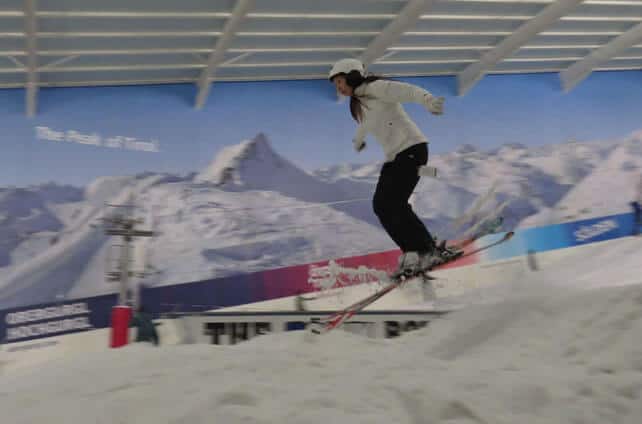
Fancy a crack at freestyle skiing or snowboarding? If the answer’s yes, don’t wait for your next ski holiday. Get yourself to your nearest indoor snow slope and sign up for some lessons.
There are six slopes spread across the UK – the SnowDome at Tamworth, The Snow Centre at Hemel Hempstead, Chillfactore in Manchester, Snow Factor in Braehead, and the Snozones in Milton Keynes and Castleford. Each has a buzzing freestyle scene, and each runs lessons for budding acrobats. Without doubt, they’re the best way to get airborne for the first time, and start your freestyle career.
Why? Well, here are seven reasons for starters.
1. In a giant fridge, it’s much easier to focus
It’s easily done. You resolve to get stuck into the terrain park the next time you’re in a ski resort. But then you wake up on the first morning of your holiday, and the pistes look like this…

What are you going to do? Turn your back on something you love in favour of the unknown? Of course not. It’s no wonder most people go home again without having ventured anywhere near a jump.
On an indoor ski slope there are no such distractions. These are training facilities, not mountains, and they’re perfect for focusing on a particular skill. You can boil your experience down to a single jump safe in the knowledge you’re not missing perfect corduroy, or a powder day.
2. The instructors are native English speakers

3. You advance in a series of small steps
You won’t be taken to a jump straight away and told to get airborne. You advance in a series of small steps, skiing a few laps of the main slope to warm up your legs, and then maybe trying to get just a little air off one of the tiny, mini-moguls that have formed on the surface. You’ll be introduced to key concepts such as a “Pop” too. That’s the basic take-off-and-landing movement you’ll need to get air and land comfortably afterwards. Only then will you try your first kicker (the freestylers’ term for a jump).
(Before you go for your first lesson you should check out our feature “How to take off and land in the terrain park” to see how your pop should look.)
4. The jumps are not going to kill you
Most skiers have a picture of a terrain park jump in their heads. It probably looks something like this…

But on a freestyle course in an indoor ski slope the jumps are actually like this…

Of course, you might fall over on your landing. But you’ve not gone far, and the landing is on loose snow. The chances of injury are slight.
5. You can make lots of progress in a single lesson
I was amazed by how far the two skiers in Will Reynolds’ clinic – Katie and Emma – went in a single two-hour lesson. Both were intermediate-level skiers. Neither had done any jumping before and were a clearly a little freaked-out by the thought of trying. But by the end of the session both were getting air off the kicker, landing safely, and loving it.
6. Relatively speaking, it’s CHEAP

7. Oh yes, and it’s LOTS of fun, too…
It may be average evening after work, but it won’t feel like that after you’ve started landing jumps. The buzz you’ll get from it will lift you up and carry you all the way to the weekend…

Interested? One useful resource while you’re planning your next move is the Go Ski, Go Board website, which has launched a new Go Freestyle service, designed to connect wannabe acrobats with their nearest freestyle scene, whether it’s on a dry slope or an indoor snow slope. Then, once you’ve mastered the basics, it’s time to visit a proper mountainside terrain park, such as the Boarder’s Playground in Westendorf, part of the Skiwelt, pictured below. It needn’t be expensive.
Also see our feature on How to Keep Improving for further advice.














Hi Sean, Could you let me have a link to the pictures that were taken at the GoSkiGoBoard event at the Snow Centre please. I was the race coach and would like a look at those taken on the race course.
Cheers
Simon
Hello Simon – can you send me your email address to becky.horton@hortonpr.co.uk and I will send you the link.